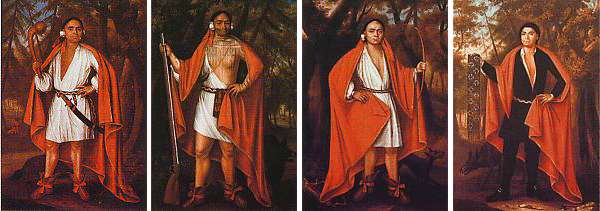Four Mohawk Kings

The Four Indian Kings or Four Kings of the New World were three Mohawk chiefs of the Iroquois Confederacy and a Mahican of the Algonquian peoples, whose portraits were painted by Jan Verelst in London to commemorate their travel from New York to meet the Queen of Great Britain in 1710. The three Mohawk were: Sa Ga Yeath Qua Pieth Tow of the Bear Clan, called King of Maguas, with the Christian name Peter Brant (grandfather of Mohawk leader Joseph Brant); Ho Nee Yeath Taw No Row of the Wolf Clan, called King of Canajoharie ("Great Boiling Pot"), or John of Canajoharie; and Tee Yee Ho Ga Row, meaning "Double Life", of the Wolf Clan, also called Hendrick Tejonihokarawa or King Hendrick. The Mohican chief was Etow Oh Koam of the Turtle Clan, mistakenly identified in his portrait as Emperor of the Six Nations. The Algonquian-speaking Mohican people were not part of the Iroquois Confederacy. Five chiefs set out on the journey, but one died in mid-Atlantic.
The four Native American leaders visited Queen Anne in 1710 as part of a diplomatic visit organised by Pieter Schuyler, mayor of Albany, New York. They were received in London as diplomats, being transported through the streets of the city in Royal carriages, and received by Queen Anne at the Court of St. James Palace. They also visited the Tower of London and St. Paul's Cathedral.
In addition to requesting military aid for defence against the French, the chiefs asked for missionaries to offset the influence of French Jesuits, who had converted numerous Mohawk to Catholicism. Queen Anne informed the Archbishop of Canterbury, Thomas Tenison. A mission was authorized, and Mayor Schuyler had a chapel built the next year at Fort Hunter (located near the Mohawk "Lower Castle" village). Queen Anne sent a gift of a silver Communion set and a reed organ. The Mohawk village known as the "Lower Castle" became mostly Christianized in the early 18th century, unlike the "Upper Castle" at Canajoharie further upriver. No mission at the latter was founded until William Johnson, the British agent to the Iroquois, built the Indian Castle Church in 1769.[1]
To commemorate the diplomatic visit to London, the Crown commissioned Jan Verelst to paint the portraits of the Four Kings. These paintings hung in Kensington Palace until 1977 when Queen Elizabeth II had them relocated to the National Archives of Canada. She unveiled them in Ottawa.
See also
References
- ↑ Snow, Dean R. "Searching for Hendrick: Correction of a Historic Conflation", New York History, Summer 2007, accessed 8 October 2011